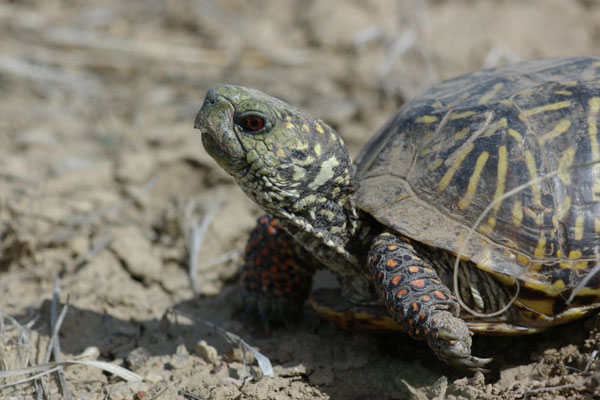 John Steinbeck's novel The Grapes of Wrath is a symbolic work of art that has been praised through history as an accurate depiction of the dust bowl period and how it affected the "Okies", or families forced from their homes to California in search of work and food. Whether the blatantly obvious or the subtle form of symbolism, the novel employs this technique very effectively throughout the novel.
John Steinbeck's novel The Grapes of Wrath is a symbolic work of art that has been praised through history as an accurate depiction of the dust bowl period and how it affected the "Okies", or families forced from their homes to California in search of work and food. Whether the blatantly obvious or the subtle form of symbolism, the novel employs this technique very effectively throughout the novel.One of the more subtle symbolic devices is the famous turtle crossing the road. This ordinary turtle encounters struggles and obstacles as it tries to get to whatever its goal is. This turtle is much like all of the Okies trying to get to California. Steinbeck does not really say where the turtle is going. I believe that this shows how the Okies didn't really know where they were going. They didn't know for certain if they would be able to get jobs once out on the west coast, yet they kept on striving to get there. They also had to face obstacles: small and large. Small obstacles, a bump in the road, a car breakdown. Large obstacles, a car out to turn you into roadkill, a police officer out to run the Okies out of the country.
Throughout the novel, several characters swerve while driving to run over various types of animals. I feel that this symbolizes any of the oppressors of the Okies. It seemed as if, in both situations, the more powerful of the two went out of its way to harm the other party. It seemed ironic how the Okies thought nothing of it even though almost the exact same thing was being done to them in a figurative sense.
One of the more obvious examples of symbolism is Steinbeck's characterization of the Bank as a monster full of hunger, or greed. This whole chapter was ingenious and effective for making its point. The following passage pretty much sums up the whole idea.
"It's not us, it's the bank. A bank isn't like a man. Or an owner with fifty thousand acres, he isn't like a man either. That's the monster."
A monster is a perfect example of greed and power. I felt that this piece of symbolism was very well executed and effective. This style of generalization and symbolism was used throughout the novel (much to my own pleasure).
Lastly, in the end of the book, Rose of Sharon breast feeds the man in the barn. I feel that this symbolizes how the migrants had been turned into savages and animals through all of their ordeals. They had no shame anymore. They did just what they needed to survive. However, it also showed how they had banded together. By the end of the book, they thought of others more than themselves.

Well done . . . I had momentarily forgotten about the turtle! It is definitely one of those parts of the novel that seems so out of place at first, but, as you determined, Steinbeck did make a connection between the turtle and the Okies.
ReplyDeleteGood job, Blakey!
ReplyDeleteI really enjoyed reading about the family, but even more so I enjoyed the in between chapters that broke everything down into the small scale or viewed all of the Okies in a general sense. It was a really interesting and different style.
ReplyDeleteInteresting that you caught the bank/monster symbolism in this age of recession. I'm impressed. I also am impressed by your explanation of the base level of existence from the migrants. Poverty clearly changes people.
ReplyDeletesounds like you really lost yourself in the Steinbeck. really meaningful writeup. my awesome nephew has put his awesomeness on virtual paper. cool.
ReplyDeleteps when's the next installment?
ReplyDelete